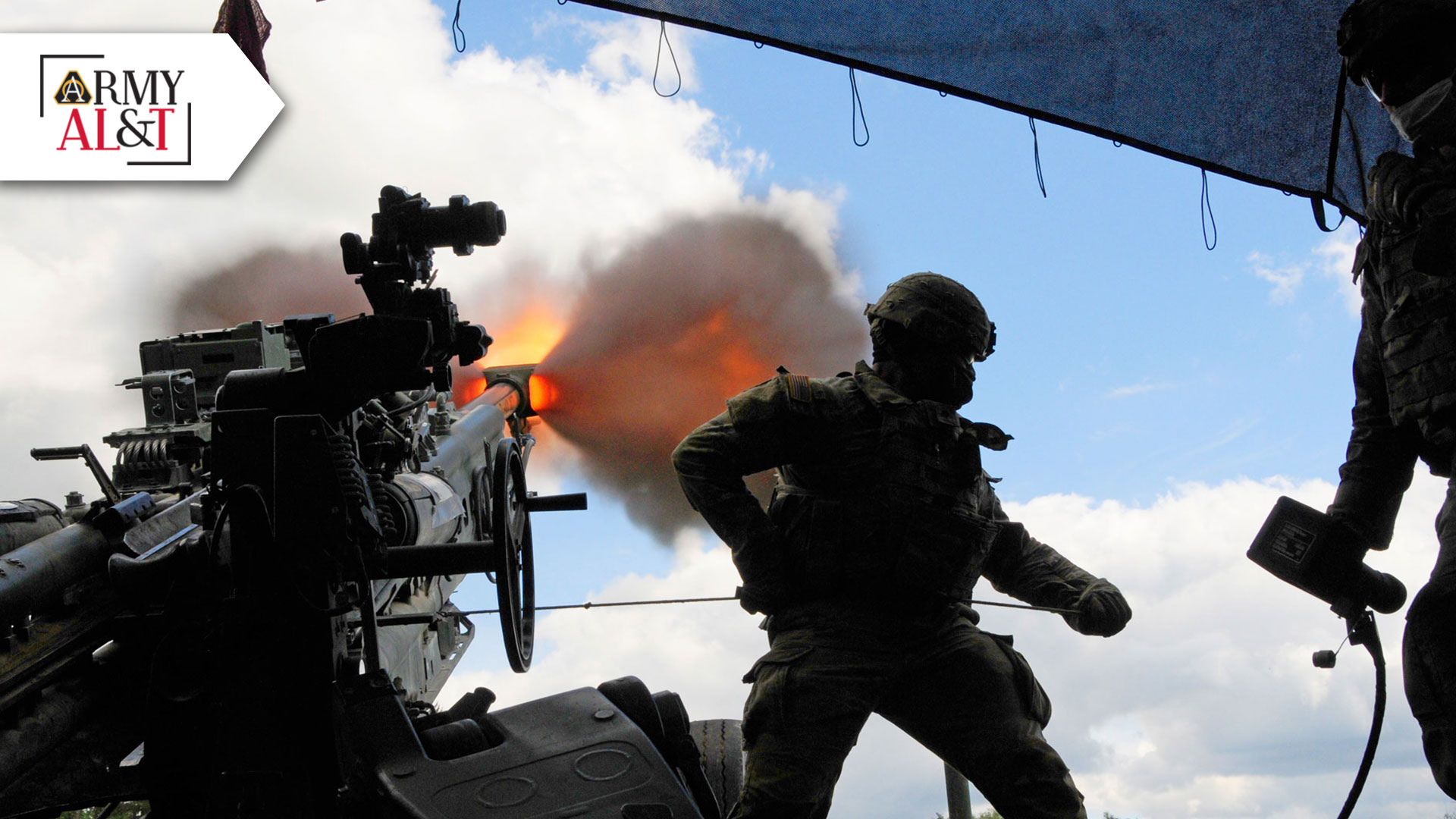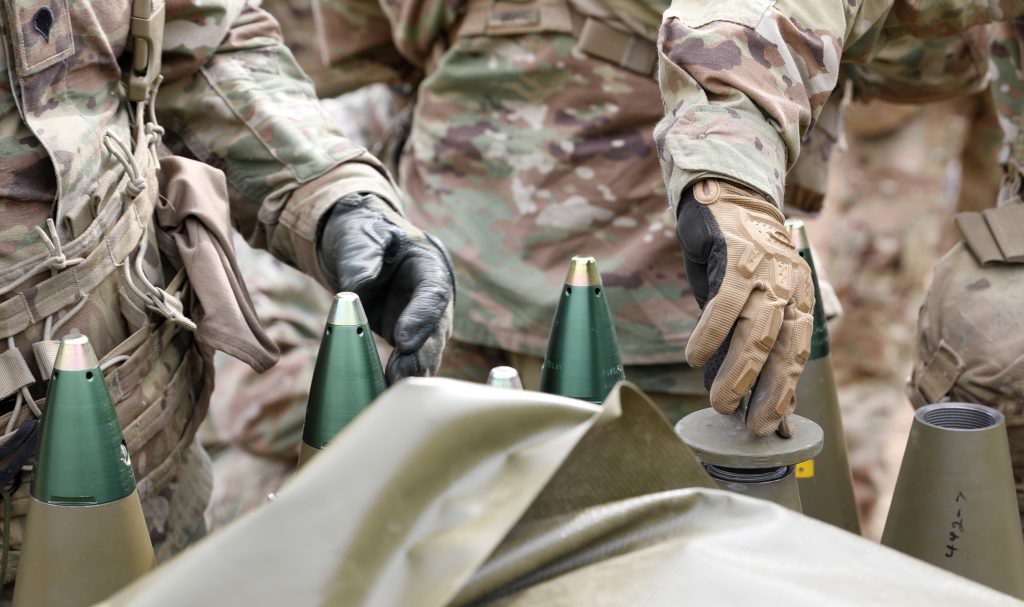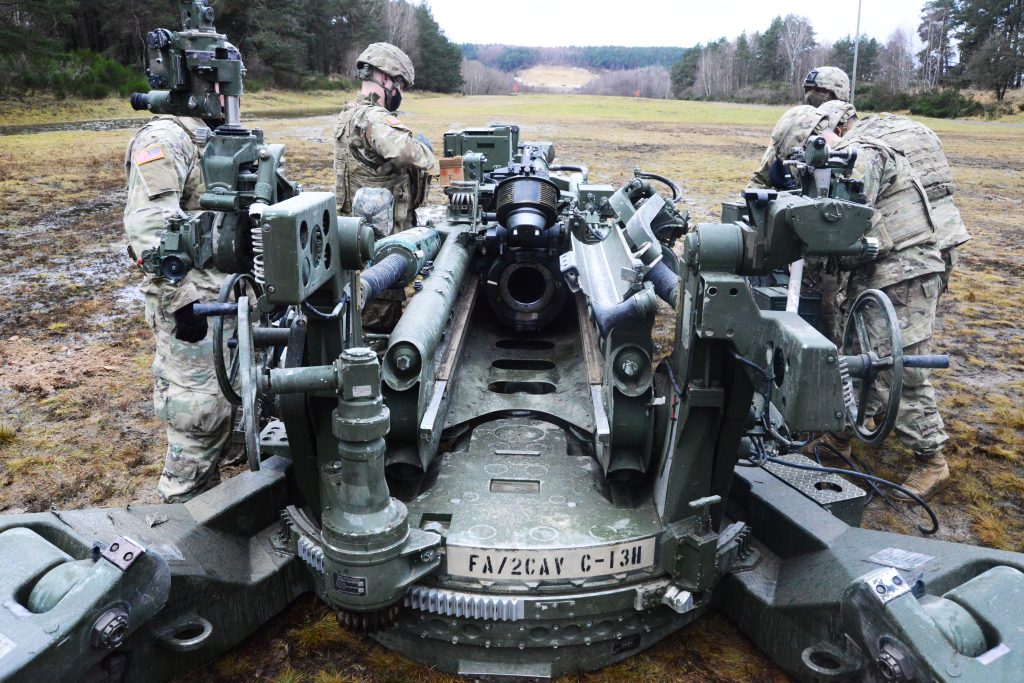
(Photo by Maj. Joseph Bush, 41st Field Artillery Brigade)
“Unusual” approaches to materiel development can be the secret to innovative weapons.
by James A. Sarruda and Lt. Col. Brian Adkins
If the movie, “Avengers: Infinity Wars” has taught us anything, it’s that—at least for comic book heroes—defeating an apparently superior army requires better technology. While the United States Army may not have the benefit of an impenetrable energy field that spans the horizon or a magical hammer of the god of thunder, it does have 155 mm cannon artillery weapons that rain down destruction like lightning from the sky. Cannon artillery, also known as the “king of battle,” delivers lethal effects to shape the maneuver commander’s fight and to change the enemy’s behavior.
As the battlefield that the Army faces becomes revolutionized with easily accessible electronics applied in new ways, Army modernization must rapidly develop new technology for ammunition to enable the Army to expand its area of effects with increased lethality. The pace of commercial technology forces new ammunition to deliver specialized effects on target, such as armor piercing or air burst capabilities. As the Army leans forward to execute multidomain operations as part of a joint force, acquisition personnel, engineers and software developers must collaborate to deliver better 155 mm ammunition. In the future, the Army’s cannon artillery ammunition must defeat the enemy’s strategic long-range systems and influence the battle from greater distances.

MORE BANG FOR THE BUCK: The Army must deliver better 155 mm ammunition in the future to be able to defeat an adversary’s long-range systems. (Photo by Staff Sgt. Michael Gresso, U.S. Army Europe and Africa)
NEXT GENERATION AREA EFFECTS
Cannon-Delivered Area Effects Munitions (C-DAEM) is an Acquisition Category II development program designed to replace cannon-delivered cluster munitions with improved effectiveness to defeat current and future threats. C-DAEM will replace cluster munitions, which separate in the air into several bombs. It will enable the maneuver commander to defeat high-priority targets with a high degree of precision at extended ranges, a new capability for 155 mm artillery systems.
The warfighter needs to immediately change the behavior of high-priority targets by either defeating them or eliminating the threat. The most effective way to achieve success is to fire less ammunition and achieve more direct hits: ammunition that includes precision technology allows artillery weapons to quickly eliminate enemy threats from great distances. This crucial capability enables the maneuver commander to complete more beneficial missions. The Product Manager for Precision Attack Cannon Munition (PACM) under the Joint Program Executive Office for Armaments and Ammunition (JPEO A&A) used an original process to competitively select a game changer that will position PACM to rapidly deliver a long-range precision-kill solution to the warfighter.
The process began at an industry day, where the C-DAEM team clearly identified the program ambitions, emphasizing the desire to expedite the advancement of emerging technologies.
Industry partners recommended that the government speed up the design process by relying on iterative development, or the art of using established engineering best practices to build upon lessons learned in earlier designs. Iterative development leverages modeling and simulation in place of singular, grand, system-focused test events. This allows the more informative component-focused tests to drive design decisions.
In order to tie iterative development in to the selection process, the government implemented a creative means of scoring the competition by organizing its program desires into a modeling and simulation tool called the “objectives hierarchy.” There are lots of ways to collect and organize technical data for a comprehensive evaluation, but it took creativity to implement a tool that assigned value to the facts and figures based on operational utility.
As the name suggests, the objectives hierarchy is simply a list of program intentions, organized into groups to allow the team to assign ranking and importance. Many of the objectives were technical metrics derived from real-world applications of the desired product. As the C-DAEM program progressed, engineers and analysts used the hierarchy to evaluate candidates across more than 100 operational scenarios by comparing both analytical and experimental data. At the end of the competition, the tool calculated a score, but it was the unique way the team connected the data to the mission that enabled the tool to choose the best solution that delivered lethal effects at the increased ranges needed to defeat strategic enemy systems.
INDUSTRY DAY ACTION
Army programs do not always choose to take technical risks early, because the acquisition process and program budget are not flexible. The C-DAEM team tackled these familiar challenges by tailoring its competitive process to communicate objectives instead of requirements, to use modeling of real scenarios in place of single occasion testing, and to accelerate technology maturation. For example, the objectives hierarchy tool communicated program intentions instead of requirements by allowing contractors to get credit for performance predictions and test reports that show understanding of their design.
This tool allowed the competitive process to evaluate more valuable information, such as performance of an electronic component, and then fast-track the knowledge gained from those smaller, more specific experiments.
The C-DAEM team held an industry day in the fall of 2018, during which government officials put forward an opportunity for defense firms to adapt to the Army’s changing conditions by outlining general operational objectives and the blue print of the competitive process. The two-day event, which included more than 100 people and 24 companies, featured representatives from the Army user community who presented operational context, such as how the enemy behaves, rather than detailed specifications.
The event clarified the Army objectives to remove tactical threats and achieve extended ranges in accordance with guidance from the U.S. Army chief of staff. On the second day of the event, individual sessions allowed each participating contactor 30 minutes to ask clarifying questions on the tactical circumstances that influence how, where and why a Soldier might use the weapon. Industry partners asked for further definition of potential threats and surroundings, and explained that additional clarification could help the detailed planning. The C-DAEM team compiled this information and created the objectives hierarchy, but would need a flexible contract vehicle to keep the program on schedule.

REVOLUTIONARY REIGN: Cannon artillery is known as the “king of battle” and delivers lethal effects to the enemy, but the Army must develop new technology for ammunition rapidly as the battlefield it faces becomes revolutionized. (Photo by Christoph Koppers, Training Support Activity Europe)
THE OBJECTIVES HIERARCHY
The C-DAEM team leveraged the flexibility enabled by the DOD Ordnance Technology Consortium other-transaction agreement to implement the objectives hierarchy scoring process. Generally speaking, that consortium is a group that encourages government, industry and academia to work together and rapidly deliver promising technology to the warfighter using an other-transaction agreement. Its structure promotes collaboration, and encourages large companies to form partnerships with the pioneering smaller companies that may develop cutting-edge technologies, but often struggle with the government’s contracting processes. (See related article on consortia, “Not Far At All,” in the Winter 2022 edition of Army AL&T: https://go.usa.gov/xtpT5.)
The C-DAEM team used the mechanism because the Army needed revolutionary technology. After all, the Avengers needed to turn the tide on the battlefield, not prolong their defeat. The consortium’s program office delivers government program objectives to industry as part of its published annual plan, which its academic partners can read and then use to collaborate and quickly propose solutions. The C-DAEM team submitted the program objectives with the consortium’s 2019 annual plan as tradeable desires, and invited the interested consortium members to provide feedback on the objectives hierarchy once again.
In the spring of 2019, the DOD Ordnance Technology Consortium, in partnership with its academic component, the National Armaments Consortium, held a general membership meeting that provided another formal opportunity for the C-DAEM team to receive feedback and confirm that industry understood the Army’s challenges before proposing solutions.
AN OBJECTIVE PROCESS
At the meeting, the C-DAEM team explained the objectives hierarchy and how to maximize scoring by maintaining lethality at increased ranges. In the absence of hard requirements, the hierarchy compiled all design data, modeling, simulation and analysis into a single evaluation tool. By tying it to the competitive process, the C-DAEM team intended for the defense industry’s finest engineers to use the same tool to inform design decisions before prototyping begins.
The objectives hierarchy assessed each contractor against four factors: schedule, performance, cost and long-term viability. The program office used the performance factor in the hierarchy, known as a range-weighted lethality index, to evaluate the number of rounds to achieve a specific amount of damage done against various enemy targets, across increasing increments of range. This allowed the program office to “weight” the performance based on range achieved, and relate it to the amount of damage done.
The range-weighted lethality index also evaluated the impacts of different weather conditions, terrains, target backgrounds, countermeasure combinations and target characteristics. After receiving feedback at the conference, the C-DAEM team announced the objectives hierarchy as the program office’s primary method of data collection in order to ensure the best design solution moves forward in development, and made the hierarchy available upon request.
By the end of the competition, the competitors provided analytical and experimental data to complete the range-weighted lethality index. The winning solution, a 155 mm smart projectile offered by Raytheon, offered significant range and lethality benefits, while managing technical risk early to realize its full potential. The C-DAEM team evaluated each competitor using the objectives hierarchy to fully understand the risks associated with the technical development of each solution.
With the help of the Army’s Data Analysis Center, the team completed statistical analysis of target engagement to characterize the performance of each solution’s explosive and fully understand its destructive abilities. The C-DAEM team also worked with the Combat Capability Development Command Armaments Center to collect experimental flight data and flight-simulation modeling to estimate range in different weapon systems and in different conditions.
Ultimately, the Raytheon concept scored highest in its range-weighted lethality index because it addressed the Army’s problems with a reasonable level of risk. It offered exceptional performance against countermeasures and significantly increased range opportunities. It also offered the Army a long-term area-effects solution by presenting opportunities to complete upgrades in the future.

PRECISION DELIVERY: Cannon-Delivered Area Effects Munitions (C-DAEM) is designed to replace cannon-delivered cluster munitions. It will help Soldiers defeat high-priority targets with precision at extended ranges. (Photo by Yuma Proving Ground, Arizona)
CONCLUSION
The future artillery-ammunition solution will influence enemy movement and turn the tide of the future battlefield.
The C-DAEM team collaborated with industry partners through multiple conferences and created a selection tool using the feedback received, to ultimately incentivize the iterative development to advance the right solution for the Army. The team succeeded because the government emphasized flexibility and the contractors took some risks.
The government leveraged the DOD Ordnance Technology Consortium other-transaction for its efficient and effective selection process that encouraged industry partners to form relationships within the consortium and align prototyping to the objectives hierarchy. The hierarchy tool enabled the C-DAEM team to select an artillery weapon capable of defeating and changing enemy behavior at longer ranges. The C-DAEM program many not have had the budget of the Avengers, but now the Army is one step closer to mirroring its success on tomorrow’s battlefield.
For more information, go to https://jpeoaa.army.mil/jpeoaa/.
JAMES A. SARRUDA works for PM PACM within JPEO A&A at Picatinny Arsenal, New Jersey, currently serving as the branch chief for the C-DAEM program. He holds a Master of Engineering degree in mechanical engineering from Stevens Institute of Technology, a B.S. in mechanical engineering from Lafayette College, and is a member of the Army Acquisition Corps.
COL. BRIAN ADKINS is the product manager for PACM within JPEO A&A at Picatinny Arsenal. He holds an M.S. in systems engineering from George Mason University and a B.S. in mechanical engineering from Virginia Tech. He is Level III certified in program management and is a member of the Army Acquisition Corps.







